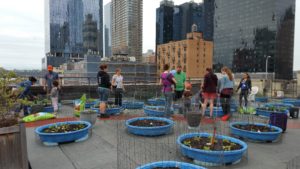Densely populated cities have limited space for growing food at ground level, but acres upon acres of wide open space in some unusual places. That is why, instead of competing with developers for premium ground space, farming operations are moving up in the world –up to the rooftops. On a recent visit to New York, I was astounded by the number of rooftop farms in the five boroughs. Some of the farms, like the Brooklyn Grange and Gotham Greens, are large scale operations providing copious amounts of produce for the area’s numerous grocery stores and restaurants. Although these farms are truly amazing, they are not easily replicable. I was lucky enough to tour three smaller-scale farms that each demonstrated growing methods that anyone with a suitable rooftop of balcony could copy.

The first was Rosemary’s restaurant, located in the West Village of Manhattan. Chef Wade took me on a tour of the garden, which is located one flight up from the restaurant and is open to the public. Rich soil and rows of greens and vegetables give the garden the feel of a traditional at-grade garden until you look up and see at eye level the tops of the trees growing in the garden across the street. With help from the Brooklyn Grange, the roof was covered with a waterproof membrane and a thick layer of felt that acts like a giant sponge, holding moisture in an environment that would otherwise dry out rapidly. Thousands of pounds of soil were transported to the roof with the aid of a crane. The garden grows greens and vegetables that serve the kitchen below. Although this garden is much larger in scale than most individuals would need or could afford to assemble, it is essentially an oversized raised bed. This illustrates that raised bed gardens are a very viable option for rooftop farming as long as measures are taken to conserve water and to prevent run-off from damaging the roof. To see what is happening now in the garden, take a look at the live rooftop webcam at http://rosemarysnyc.com/about/rooftop-webcam/.
 The Hell’s Kitchen Farm Project takes a much different approach to water conservation and management. The 4,000 square foot roof at the top of Metro Baptist Church is dotted by plastic kiddie pools that serve as raised bed gardens. Each garden consists of a small pool drilled with drainage holes located at the lower edge of the pool wall. Pools with drainage holes are nested inside a second, intact pool. This approach allows moisture to drain from the soil in the upper pool into the empty space in the lower pool where it is held for reabsorption as the soil begins to dry out. Materials to set up dozens of these simple garden were relatively inexpensive and easy to procure. This keeps expenses low for the non-profit that grows produce for the local food pantry with the aid of volunteers. But the real beauty of this project is how replicable it is for individuals who want a small garden at home on their own roof or balcony. Many of the volunteers come with the desire to give back to their community, but also to learn from more experienced gardeners how to grow food in the city. The knowledge and simple techniques that they obtain at the Hell’s Kitchen Farm Project can certainly help almost anyone to achieve a prosperous garden of their own. Find out more about the project at HKFP.org.
The Hell’s Kitchen Farm Project takes a much different approach to water conservation and management. The 4,000 square foot roof at the top of Metro Baptist Church is dotted by plastic kiddie pools that serve as raised bed gardens. Each garden consists of a small pool drilled with drainage holes located at the lower edge of the pool wall. Pools with drainage holes are nested inside a second, intact pool. This approach allows moisture to drain from the soil in the upper pool into the empty space in the lower pool where it is held for reabsorption as the soil begins to dry out. Materials to set up dozens of these simple garden were relatively inexpensive and easy to procure. This keeps expenses low for the non-profit that grows produce for the local food pantry with the aid of volunteers. But the real beauty of this project is how replicable it is for individuals who want a small garden at home on their own roof or balcony. Many of the volunteers come with the desire to give back to their community, but also to learn from more experienced gardeners how to grow food in the city. The knowledge and simple techniques that they obtain at the Hell’s Kitchen Farm Project can certainly help almost anyone to achieve a prosperous garden of their own. Find out more about the project at HKFP.org.
 The third garden that I visited, located less than a block from Rosemary’s, was the aeroponic garden on the roof of Bell, Book and Candle Restaurant. Aeroponic systems, also known as Tower Gardens, grow produce in a soil-free environment. Although the rooftop is not large, 60 tower gardens produce enough food vertically in three dimensions to supply 60 percent of the restaurant’s fresh produce in season. Each tower is self-contained, automatically watered and fertilized, and easy to maintain without the risk of soil-borne diseases. The soil-free environment also creates a relatively light weight garden that grows an incredible amount of food without risking the integrity of the roof. Tower gardens have great potential for the home gardener, as well. The initial investment to buy a tower garden from TowerGarden.com is approximately $550 at this writing, plus the ongoing cost to purchase nutrients for the system. Although this is certainly more expensive than growing in a kiddie pool, the three dimensional configuration of the tower garden provides much more growing area for roughly the same footprint. For the more frugal or handy gardener, a cursory internet search for DIY Tower Gardens will yield dozens if not hundreds of ideas to create your own vertical garden system. View some beautiful photos of the Bell, Book and Candle rooftop farm at http://bbandcnyc.com/photos/gallery/rooftop-garden/.
The third garden that I visited, located less than a block from Rosemary’s, was the aeroponic garden on the roof of Bell, Book and Candle Restaurant. Aeroponic systems, also known as Tower Gardens, grow produce in a soil-free environment. Although the rooftop is not large, 60 tower gardens produce enough food vertically in three dimensions to supply 60 percent of the restaurant’s fresh produce in season. Each tower is self-contained, automatically watered and fertilized, and easy to maintain without the risk of soil-borne diseases. The soil-free environment also creates a relatively light weight garden that grows an incredible amount of food without risking the integrity of the roof. Tower gardens have great potential for the home gardener, as well. The initial investment to buy a tower garden from TowerGarden.com is approximately $550 at this writing, plus the ongoing cost to purchase nutrients for the system. Although this is certainly more expensive than growing in a kiddie pool, the three dimensional configuration of the tower garden provides much more growing area for roughly the same footprint. For the more frugal or handy gardener, a cursory internet search for DIY Tower Gardens will yield dozens if not hundreds of ideas to create your own vertical garden system. View some beautiful photos of the Bell, Book and Candle rooftop farm at http://bbandcnyc.com/photos/gallery/rooftop-garden/.


